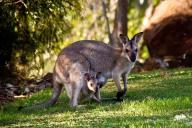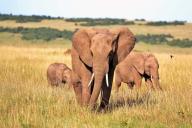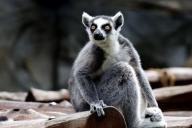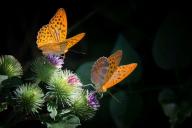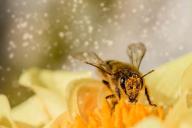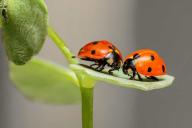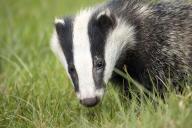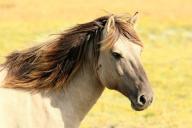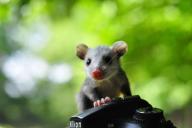wild nature
Nature is amazing: Learn more about wallabies
Being one of the most recognizable symbols of Australia, wallabies aren't that well-known around the world. These animals might be pretty much like kangaroos, but they also have some unique features helping them to stand out.
Kate Yakimchuk animal facts wildlife facts Animals 11 January 2024Rhinos: Interesting Facts – Amazing Animals
The white rhinoceros is the largest representative of the rhinoceros family. Inhabitant of savannas and woodlands. This is a huge mammal - the weight of old males reaches 4-4.5 tons.
Diana Dashkevich nature wildlife wild animals facts Animals 11 January 2024Elephants: Interesting Facts – Amazing Nature
Elephants are natural eco-warriors and carbon sequesters, so protecting their populations is vital for both the environment and the species.
Diana Dashkevich wild animals nature animal facts facts Animals 10 January 2024Lemurs: Interesting Facts – Amazing Nature
The Madagascar name is Varika. It lives in southeastern Madagascar from the Mananara River near Vangaindrano, south to Fort Dauphine.
Diana Dashkevich nature wild animals animal facts Animals 10 January 2024Butterflies and the Ecosystem: Interesting Facts – You Didn't Know About It
Butterflies are one of the best pollinators, after bees. Some types of butterflies provide silk to humans.
Diana Dashkevich nature butterflies fun facts Animals 9 January 2024Nature is amazing: The most unusual nests – birds that create magic
Not all birds make nests, but some of the nesting birds create really unusual and impressive nests for laying eggs. These nests can be made of unusual materials, have unusual shapes, or be special in any other way.
Kate Yakimchuk bird facts nests habits Animals 9 January 2024Interesting Facts: Why Are There A Lot of Insects in Australia – You Didn’t Know About It
Australia's animals are diverse and very different from those found on other continents.
Diana Dashkevich nature wildlife wild animals facts Animals 8 January 2024Good to Know: What Are Insects For - Amazing Nature
The role of insects in nature is the destruction of forest pests, pollination of most plants on Earth, and participation in the cycle of substances in nature.
Diana Dashkevich nature insects garden insects facts Animals 8 January 2024Nature is amazing: Protecting your food from seagulls – that's not easy
From all birds, seagulls are well-known for their reckless behavior and constant attempts to steal your food. If you want to spend a nice day outside, or have a picnic, then you have to think about protecting your food in advance.
Kate Yakimchuk food protection bird facts Animals 8 January 2024A new study: Decoding primate language – is it possible?
A team of specialists conducted a study to understand how we recognize and differentiate the vocal sounds of primates and humans. They found that our ability to identify these sounds is not solely based on our genetic similarity but also on the type of frequencies emitted.
Kate Yakimchuk research languages intelligence Animals 7 January 2024A new discovery: The insect decline – common species are endangered
A recent study found that the decrease in insects is mainly happening to the species that are found in larger numbers locally. The study showed two important things. First, the species that used to be the most abundant are decreasing more than others.
Kate Yakimchuk research insects endangered species ecology Animals 6 January 2024Badger: Interesting Facts – Amazing Animal World
The color of the head is recognizable: the white muzzle has two dark stripes stretching from the nose (the vibrissae area on the upper lip) to the ears, the tips of which are also white. The badger is omnivorous, but prefers animal food.
Diana Dashkevich wild animals wildlife nature animal facts Animals 5 January 2024A new discovery: Bugs that help bugs – nature is amazing
Microbes, the tiny organisms that live on and inside us, are known to play a role in our health. But now, scientists from Japan and the US have found that the microbes living in fruit flies can actually help them reproduce better.
Kate Yakimchuk research insect facts ecology Animals 5 January 2024A new study: Bison population – using science to help the nature
During the last ice age, many bison lived in Europe. However, by 1927, the European bison became extinct in the wild, and only about 60 were left in captivity.
Kate Yakimchuk research endangered species Animals 5 January 2024Interesting Facts: Evolution of Horses - You Didn't Know About It
The evolution of horses began in the Eocene, about 55 million years ago.
Diana Dashkevich wild animals nature evolution animal facts horses Animals 4 January 2024A new study: Stopping the disease spread – helping the nature
Scientists have come up with a new way to figure out how diseases spread in wild animals and how many samples are needed to detect them. Wildlife organizations often don't have enough money and staff to collect a sufficient number of samples to accurately understand how common diseases are in animals.
Kate Yakimchuk nature research diseases science Animals 4 January 2024A new study: Helping the endangered species – technologies will help us
Since the Endangered Species Act (ESA) was enacted 50 years ago, experts have discussed its evolution and future. A team of specialists emphasize the importance of technology in addressing the mass extinction we are experiencing.
Kate Yakimchuk research endangered species help ecology Animals 4 January 2024A new study: Jellyfish magic – secret animal abilities
Some animals can have absolutely amazing skills that humans don't. A tiny jellyfish called Cladonema can grow back a lost tentacle in just a couple of days, like magic!
Kate Yakimchuk research animal adaptation Animals 4 January 2024A new study: Ants are amazing – they can use antibiotics
The Matabele ants eat only termites, but hunting them is risky because the termite soldiers fight back. These ants have a smart way of taking care of their injured buddies - they can tell if a wound is infected or not.
Kate Yakimchuk research ants garden insects Animals 4 January 2024Wildlife: Which Animals Play Dead – Interesting Facts
Many animals pretend to be dead when in danger. This is done, for example, by Virginia opossums (Didelphis virginiana) and common grass snakes (Natrix natrix). This behavior is also common among insects, including ants.
Diana Dashkevich wild animals wildlife animal facts nature Animals 3 January 2024